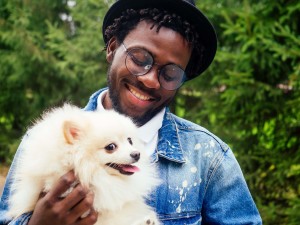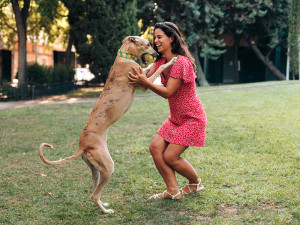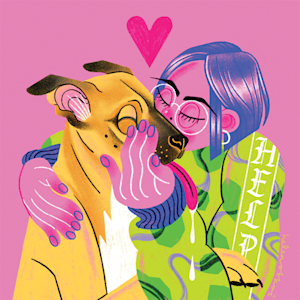A New Study Debunks the Theory That “Puppy Dog Eyes” Are for Humans’ Benefit
Apparently wild dogs can be pretty cute, too.

share article
My dog, Finn, is not the sharpest tool in the shed. He’ll come when called — mostly. When told to “sit” and “stay,” he’ll sort of loiter. And the months I’ve spent trying to teach him basic tricks opens in a new tabhave brought nothing but humiliation to us both. But, no matter what, I always say “Good dog, Finn!” I have to. It’s the desperate look in his eyes. This facial expression speaks volumes. It says that he loves me, he hates to disappoint, and he’d give anything to make things right.
It’s a wildly winsome, beseeching look that would be too on-the-nose for an animated bunny in a kids movie. It’s a look that self-captions as, “Awww,” or “Who, me? ” The expression is so lethally, infamously cute that a Danish pop star wrote a songopens in a new tab about it. I saw it on Finn the other night, right after he woke up the entire household at 2 a.m. with loud, alarming barksopens in a new tab because a neighbor deposited a little recycling.
That deeply manipulative, adorably effective little smirk Finn fixed me with is what researchers have deemed “puppy-dog eyes.” But new research published in the journal The Anatomical Recordopens in a new tab shows dispels a 2019 studyopens in a new tab that dogs got this adorable look as a result of domestication by humans. This new study finds that it is also present in wild dogs.
They didn’t evolve just for us, after all.
The 2019 study reported that an eye muscle, entirely absent in wolves, enables subtle facial movements that “increase paedomorphism.” Anne M. Burrows, as one of the study’s authors, told Australia’s ABC Newsopens in a new tab that this is a buzzkill way of saying that dogs “hijack our emotions.”
In other words, the study found that dogs have evolved over time to mimic our facial expressions and, as a result, create a very human-like, beseeching look that allows them to get exactly what they want from us. But just because that muscle wasn’t present in wolves, does it mean only domesticated dogs have the puppy-eye dog capability?
Heather Smith, a researcher at Midwestern University and her team wanted to dig deeper. When they studied a deceased African wild dog (Lycaon pictus), they found that the puppy-dog eye muscles were just as developed in that dog as they were in dogs who live with humans.
“So, it kind of debunks the idea that domestic dogs are the only canids that have this, and that they evolved specifically for us,” Smith told LiveScienceopens in a new tab.
Pups and their people share a “mutual gaze.”
Even if this charming attribute of dogs’ eyes is not the result of humans’ influence, it has contributed to our bond with our pups. In a statement about the 2019 studyopens in a new tab, Burrows, senior author, says that these tiny facial muscles, which flex and tire just as quickly, create a “mutual gaze” between humans and dogs that doesn’t happen between us and other pets.
It’s safe to say that when we see our dogs looking at us like we used to gaze at our parents when we wanted that extra bowl of ice cream, we can relate to them. Regardless of how they originally developed those pleading eyes, they do manipulate us. Finn is living proof of that — quickly disarming my frustration with just one look.
It’s not like we can complain: We love to give them exactly what they want. And apparently, if we come across any wild African dogs, we might similarly influenced by them and want to fulfill their every desire. Guessing they might not be as satiated by pet store-bought treats, though.
Research:
Study Reveals the Science Behind Those Irresistible Puppy-Dog Eyesopens in a new tab
The Science Behind Puppy-Dog Eyes, and Other Ways our Canines Communicate With Usopens in a new tab
Puppy Eyes Didn't Evolve Just for Humans, Study of Wild Dogs Findsopens in a new tab

Chris Norris
Chris Norris is a writer, reporter, author, and longtime companion to West Highland terrier Gus, recently departed but intensely loved. Chris Norris is has written for The New Yorker, New York Magazine, The New York Times Magazine, Rolling Stone, GQ, Details, and NPR’s “All Things Considered.” He lives in New York City with his wife and 10-year-old son.
Related articles
![Jack Russell puppy grunting while laying on blanket and crying out]() opens in a new tab
opens in a new tabListen Up! Your Puppy Is Trying to Talk to You
How to make sense of all those grunts and whines.
![Two happy Golden Retriever dogs sitting on the bed together]() opens in a new tab
opens in a new tabDo Dogs Have Besties?
They’re not exactly crafting friendship bracelets for each other, but dog bonds mean something.
![Wolfdog (Wolf/Dog Hybrid) don't always make good pets]() opens in a new tab
opens in a new tabDo Wolf Dogs Make Good Pets?
Experts say these hybrid animals should be wild and free.
![Portrait of a woman playing and having fun in the park with her big pet, a greyhound dog.]() opens in a new tab
opens in a new tabHow’s Your Dog Feeling? Check Their Tail
If your dog’s tail is wagging “to the left, to the left,” as Beyoncé says, it could mean they’re anxious.
![A woman walking 5 dogs on leashes outside.]() opens in a new tab
opens in a new tabBreed Does Not Equal Behavior—Here’s Why
A new study found that a dog’s breed accounts for less than 10 percent of their behavior.
![illustration of multi-colored dogs]() opens in a new tab
opens in a new tabIs Your Dog Tricky to Train? Here’s Why You Shouldn’t Feel Guilty
It’s important to remember that dogs are individuals, so training isn’t one-size-fits-all.
![]() opens in a new tab
opens in a new tabParenting a Dog Isn’t So Different From Raising a Kid, After All
OK, OK, don’t come for us. We know dogs and kids are very different to raise, but this study finds they respond to different parenting styles in similar ways.








